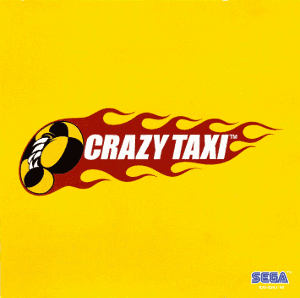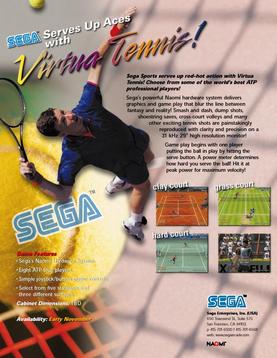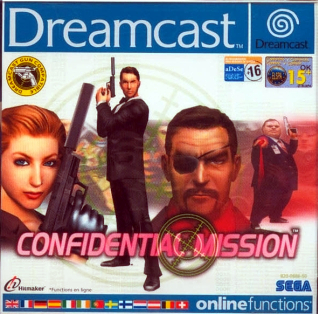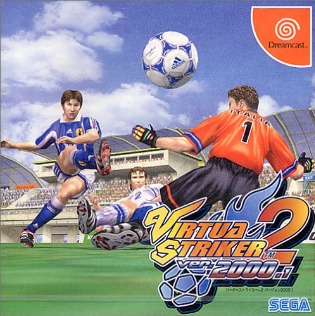
The Sega Saturn is a home video game console developed by Sega and released on November 22, 1994, in Japan, May 11, 1995, in North America, and July 8, 1995, in Europe. Part of the fifth generation of video game consoles, it is the successor to the successful Genesis. The Saturn has a dual-CPU architecture and eight processors. Its games are in CD-ROM format, including several ports of arcade games and original games.

The Dreamcast is a home video game console released by Sega on November 27, 1998, in Japan; September 9, 1999, in North America; and October 14, 1999, in Europe. It was the first sixth-generation video game console, preceding Sony's PlayStation 2, Nintendo's GameCube, and Microsoft's Xbox. The Dreamcast was discontinued in 2001, ending Sega's 18 years in the console market.

Crazy Taxi is a racing video game developed and published by Sega. It is the first game in the Crazy Taxi series. The game was first released in arcades in 1999 and then was ported to the Dreamcast in 2000. Gameplay is based on picking up taxi customers and driving to their destination as quickly as possible. Reception to Crazy Taxi has been mostly positive. It was ported to other platforms numerous times, including the PlayStation 2 and GameCube by Acclaim in 2001, and then Windows in 2002.

Phantasy Star Online is an online role-playing game (RPG) developed by Sonic Team and published by Sega in 2000 for the Dreamcast. It was the first online RPG for game consoles; players adventure with up to three others over the internet to complete quests, collect items and fight enemies in real-time action RPG combat. The story is unrelated to previous games in the Phantasy Star series.

Sonic Adventure 2 is a 2001 platform game developed by Sonic Team USA and published by Sega for the Dreamcast. It features two good-vs-evil stories: Sonic the Hedgehog, Miles "Tails" Prower, and Knuckles the Echidna attempt to save the world, while Shadow the Hedgehog, Doctor Eggman, and Rouge the Bat attempt to conquer it. The stories are divided into three gameplay styles: fast-paced platforming for Sonic and Shadow, multidirectional shooting for Tails and Eggman, and action-adventure exploration for Knuckles and Rouge. Like previous Sonic the Hedgehog games, the player completes levels while collecting rings and defeating enemies. Outside the main gameplay, they can interact with Chao, a virtual pet, and compete in multiplayer battles.

Virtua Tennis, known in Japan as Power Smash, is a 1999 tennis arcade game created by Sega. The player competes through tennis tournaments in an arcade mode. It was ported to the Dreamcast in 2000, and to Windows in 2002. A Game Boy Advance version was also released in 2002, followed by an N-Gage version in 2003. For the home console market, the game was expanded with the introduction of the campaign mode.

Yu Suzuki is a Japanese game designer, producer, programmer, and engineer, who headed Sega's AM2 team for 18 years. Considered one of the first auteurs of video games, he has been responsible for a number of Sega's arcade hits, including three-dimensional sprite-scaling games that used "taikan" motion simulator arcade cabinets, such as Hang-On, Space Harrier, Out Run and After Burner, and pioneering polygonal 3D games such as Virtua Racing and Virtua Fighter, which are some of the games besides others from rival companies during that era credited with popularizing 3D graphics in video games; as well as the critically acclaimed Shenmue series. As a hardware engineer, he led the development of various arcade system boards, including the Sega Space Harrier, Model 1, Model 2 and Model 3, and was involved in the technical development of the Dreamcast console and its corresponding NAOMI arcade hardware.

Samba de Amigo is a rhythm game developed by Sonic Team and published by Sega. The game was released in arcades in December 1999, and for the Dreamcast video game console in 2000. A port for the Wii was also developed by Gearbox Software and Escalation Studios and released in 2008. Samba de Amigo draws on Latin American culture and its gameplay involves the player using controllers shaped like maracas to match a series of patterns displayed on-screen. The music is made of primarily popular Latin music songs rather than common or traditional samba. The game also features non-Latin pop songs.
In the history of video games, the sixth generation era is the era of computer and video games, video game consoles, and handheld gaming devices available at the turn of the 21st century, starting on November 27, 1998. Platforms in the sixth generation include consoles from four companies: the Sega Dreamcast (DC), Sony PlayStation 2 (PS2), Nintendo GameCube (GC), and Microsoft Xbox. This era began on November 27, 1998, with the Japanese release of the Dreamcast, which was joined by the PlayStation 2 on March 4, 2000, the GameCube on September 14, 2001 and the Xbox on November 15, 2001, respectively. On March 31, 2001, the Dreamcast was among the first to be discontinued. Xbox in 2006, GameCube in 2007 and PlayStation 2 was the last, in January 2013. Meanwhile, the seventh generation of consoles started on November 22, 2005, with the launch of the Xbox 360.

Sega AM Research & Development No. 3, known as Hitmaker Co., Ltd. from 2000 to 2004, is a defunct division of Sega, a Japanese video game company. Established by 1993, AM3 was managed by Hisao Oguchi and developed a number of arcade games for Sega. Series introduced by AM3 include Virtual On, Sega Rally, Crazy Taxi, and Virtua Tennis. AM3's main focus was on arcade games until the release of the Dreamcast. Additionally, developers Tetsuya Mizuguchi and Kenji Sasaki developed Sega Rally Championship with AM3 before departing to form AM Annex, which later split into Sega AM9 and Sega AM5.

Sega AM Research & Development No. 2, previously known as SEGA-AM2 Co., Ltd., is a video game development team within the Japanese multinational video game developer Sega. Yu Suzuki, who had previously developed arcade games for Sega including Hang-On and Out Run, was the first manager of the department.

Virtua Tennis 2, known as Tennis 2K2 in North America and Power Smash 2 in Japan, is a sequel to Virtua Tennis that was released for the Sega Dreamcast, Sega NAOMI arcade unit and Sony's PlayStation 2 in 2001–2002. New features included the ability to slice and play as female players such as Monica Seles, Serena Williams, Venus Williams and Lindsay Davenport and the males such as Patrick Rafter, Magnus Norman, Thomas Enqvist and Carlos Moyá and mixed doubles matches. The game was created and produced by Hitmaker, with Acclaim Entertainment publishing it in Europe for the PS2. This was the last Virtua Tennis game to be released for the Dreamcast following its discontinuation.

GD-ROM is a proprietary optical disc format originally used for the Dreamcast video game console, as well as its arcade counterpart, the Sega NAOMI and select Triforce arcade board titles. It was developed by Yamaha to curb piracy common to standard CDs and to offer increased storage capacity without the expense of the fledgling DVD-ROM. It is similar to the standard CD-ROM except that the pits on the disc are packed more closely together, resulting in a higher storage capacity of 1 gigabyte, a 30% increase over a conventional CD's capacity of 700 megabytes.

Crazy Taxi is a series of racing games developed by Hitmaker and published by Sega. It was first available as an arcade video game in 1999, then released for the Dreamcast console in 2000. It is the third best-selling Dreamcast game in the United States, selling over a million copies. The game was later ported to the PlayStation 2, GameCube, and IBM PC compatibles with sequels also appearing on the Xbox, Game Boy Advance, and PlayStation Portable systems.

Confidential Mission is a light gun game published by Sega, first available as an arcade game, then ported to the Dreamcast. The game is in the same style as the Virtua Cop series or The House of the Dead series, with support for one or two players. The game was developed by Sega's Hitmaker development team and first released in 2000. Its plot is of the same vein as James Bond and Mission: Impossible. Despite it also having an arcade release, it never enjoyed the popularity of the Virtua Cop nor The House of the Dead series, which were also produced by Sega.

Beach Spikers is a beach volleyball video game released in Japanese arcades in 2001. The game was developed in-house by Sega AM2 and published by Sega. A GameCube port, renamed Beach Spikers: Virtua Beach Volleyball, was released in 2002 for all regions.

Virtua Fighter 3 is the sequel to 1994's Virtua Fighter 2 and the third fighting game in the Virtua Fighter series, developed by Sega AM2 and published by Sega in 1996. It was the first arcade game to run on the Sega Model 3 system board.
Virtua Fighter is a series of fighting games created by Sega AM2 and designer Yu Suzuki. The original Virtua Fighter was released in December 1993 and has received four main sequels and several spin-offs. The highly influential first Virtua Fighter game is widely recognized as the first 3D fighting game released.

Virtua Striker 2 is a sports video game developed and published by Sega for arcades in 1997. It is the sequel to the 1994 video game Virtua Striker, and the second game in the Virtua Striker series. A series of updates was released from 1998 to 1999, starting with Virtua Striker 2 ver. 1998 and ending with Virtua Striker 2 ver. 2000.1, that latest update being released for the Dreamcast in Japan in 1999, and then internationally in 2000, with the North American version re-titled to Virtua Striker 2. A sequel, Virtua Striker 3, was released in 2001.

Virtua Tennis is a series of tennis simulation video games started in 1999 by Sega AM3. The player competes through tennis tournaments and various arcade modes. While originally released for arcades, all games in the series have been ported to other platforms, including most major consoles.


















